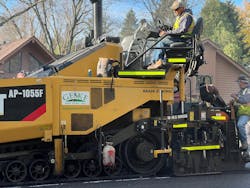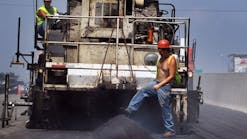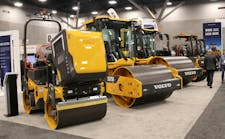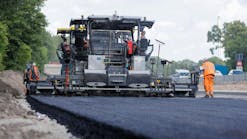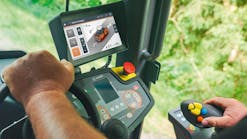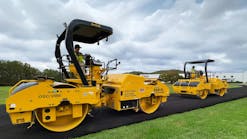Asphalt pavers have grown more sophisticated with the latest technologies, but one of the most basic components on the paver is still one of—if not the—most important: the screed.
The screed plates on most asphalt pavers may not be much more than pieces of shaped sheet metal, says Canada-based metal fabricator Axton Manufacturing, but without a well-maintained and properly adjusted screed, a paving machine cannot lay down a flat, even layer of asphalt.
See our Gallery of asphalt pavers.
An Axton blog points out that maintaining paver screed plates is not a particularly complex process and doing so can significantly extend the working lifespan of any paver screed with a few simple tasks. However, it is also important to know when a paver screed has become damaged beyond repair and needs to be replaced.
When it is time for replacement, paver manufacturers have multiple offerings for varying paving widths. There's a sampling of the newest screed models below.
Plate care stretches life
Daily maintenance of an asphalt paver's screed is considered essential during the paving season and recommended during extended periods of downtime.
The most important part of any screed maintenance routine is making sure that the screed plate remains level and properly always aligned. If the plate is even slightly out of alignment, the asphalt mat it creates will be uneven, with an inconsistent compression profile that can significantly reduce the short- and long-term durability of the asphalt, Axton says.
Fortunately, aligning a screed is a process that can be performed using ordinary stringline. Make sure to stringline both the front and rear edge of the screed plate, as poor adjustment at either end can reduce grade uniformity in asphalt mats.
Preventing rust and corrosion from forming on the screed plate(s) is also a vital part of screed maintenance. Most screed plates are protected from rust by tough, anti-corrosive paints or powder coatings. But asphalt itself can be highly corrosive. Any dried asphalt or pieces of constituent aggregate that are left on the plate for extended periods can cause widespread corrosion and damage.
Screed cleaning is easiest to perform just after the end of the working day, while the screed plates are still hot and any leftover asphalt and aggregate has not had time to harden and set. If the screed plates are still reasonably hot, they can usually be effectively cleaned with pressure washers and basic scraping tools.
Even the most well-maintained screed plates do not last forever, and eventually corrosion, wear and tear, or mechanical malfunctions will damage a screed plate beyond repair. If a screed plate has significant amounts of visible corrosion, or if it has been pierced or gouged by a malfunctioning component (such as a misaligned auger), it should be replaced as soon as possible, Axton says.
Aging screed plates will also suffer wear at points where they are fastened to the main body of the screed. Worn screen plates fall out of alignment more readily and are more difficult to maintain, so replace them to save time on maintenance, even if they are still usable.
Axton recommends purchasing replacement parts from a reputable parts dealer specializing in road construction equipment parts. These suppliers can obtain OEM replacement parts direct from paving machine manufacturers, and many also offer aftermarket plates that can be superior to factory-fitted plates.
How to spec asphalt screeds
Wirtgen Group's Vögele makes extending screeds and fixed-width screeds.
The operating principle of its extending screeds is the single-tube telescoping system. Even at maximum extension, the three-part large-diameter telescopic tube is firmly anchored at half its length, and optimally stabilized, the company says.
Fixed-width screeds characterized by high stiffness. This allows them to pave surface layers seamlessly in widths of up to 59 feet. With hydraulically extendable attachments, even fixed-width screeds can be varied in width by up to just over 4 feet to either side.
The company offers its screeds in different compaction variants: The suffix V denotes screeds with a vibration compacting unit, TV denotes an additional Tamper, and TP1 and TP2 denote high-compaction screeds with one or two pressure bars. Some of the company’s Super screeds in the mini and compact class and the VF and VR screeds for North America are only equipped with vibration, while other markets mainly utilize the TV version, i.e. also with a tamper.
The tamper actively compacts the mix under the screed plate, which is meant to ensure high precompaction of the asphalt layer. A correctly set tamper is of key importance for the compaction result and for the floating behavior of screeds, Wirtgen says.
Adjusting the tamper stroke mechanically is very time-consuming, so it is often not adjusted at all. The hydraulic tamper stroke adjuster was developed to avoid this. It enables operators to set the optimum tamper stroke for paving jobs at the press of a button: With the latest screeds, the tamper stroke is changed to 4 or 8 mm at the push of a button on the control panel.
Hydraulically actuated impulse pressure bars are at the heart of high-compaction technology. With this technology, the TP1, TP2, and TP2 Plus, fixed-width screeds achieve maximum compaction. The AB 500 TP2 Plus and AB 600 TP2 Plus are the company’s most powerful fixed-width screeds. They are primarily used in the InLine Pave train.
With this method of resurfacing, the surface layer immediately follows the binding layer. Here, the high-compaction screed compacts the binder layer with values of up to 98 percent, but without rolling.
Common to all screeds is the screed electrical heating system. It brings all parts in contact with the material, such as the screed plate and the compaction units, up to temperature quickly and evenly. Operation is via the ErgoBasic operating consoles for Classic Line pavers and via the ErgoPlus 3 screed consoles for Premium Line pavers.
Both operating concepts are based on the same principle, namely to make work easier and to allow switching between different screeds without the need for familiarization.
A Vögele Pave Width Configurator on the company’s website is an interactive application that shows how to spec a paver’s auger and screed. Based on the pave width required for a project, it guides the user step by step through the process of finding an optimal configuration.
Once a paver model is chosen, the configurator suggests the screed and then a custom-fit auger extension mounting kit to match the required pave width, all the while showing helpful size diagrams and photos.
Dynapac Mat Master screeds are equipped with DiveStop and Active Screed Assist. The double width (10- to 20-foot or 8- to 16-foot) heavy-duty screed design is engineered to pave highways, new construction, or large commercial job sites in as few passes as possible.
“The DiveStop basically helps not to create a mark in the mat because it lifts the screed up just a little bit with the hydraulic pressure so you don’t settle your screed on the mat,” says Vijayakumar Palanisany, Dynapac product specialist.
“On thin layers, you can use this technology so you don’t crush aggregates because of the heavy-weight screed. We have a very strong, heavy-weight screed. When you pave two inches with small materials, you can use the technology not to crush aggregates.”
BOMAG offers Cedarapids Stretch 16/20 Electric screeds (the numbers refer to maximum widths without extensions). They are hydraulic extendable screeds for mainline and commercial paving.
“They allow infinitely variable widths from 10 to 20 feet," says Chris Colwell, VP of paving and milling for the company. "Electric-over-hydraulic controls provide easy, fast, and accurate screed adjustments. The reversible screed bottoms are made of hardened alloy steel for high wear resistance and long service."
The Screed Assist System, which Colwell says is an industry exclusive, eliminates screed setting during stop-and-go paving to improve mat quality.
Astec’s Roadtec has three groups of screeds available: the S Series, EZIV Series, and EZR2 Series.
The S Series includes the S-8, an 8-foot model and the S-10, a 10-foot model. Both the S-8 and the S-10 are fixed width, bolt-on extendable screeds. The bolt-on extensions match the main screed plate. There is never a concern about adjusting different angles of attack for different sections, Astec says. The S screeds reach 16 feet and 30 feet, respectively.
The S-Series is outfitted with hydraulic strikeoffs that can be articulated from 6.6 percent positive to 3.3 percent negative.
Astec’s Carlson EZIV has wide-width ability. Astec says it has helped contractors to earn multiple Sheldon G. Hayes Awards and other accolades. It is a heavy-duty screed platform for commercial, municipal, and highway-class applications. The front-mount screed features a single slide extension support system combined with heavy-duty, adjustable wear components.
Available in 8-foot and 10-foot models, the EZIV can be mounted to all current North American models offered by the major paver manufacturers. The screed platform can also be retrofitted on to nearly any previous North American highway-class paver, combining like-new performance with a fleet’s dependable workhorse.
The EZR2 is for paving widths up to 22 feet in the 8-foot model and 30 feet in the 10-foot. It combines many of Carlson’s screed features (including Safety Edge, LED blade light, joint density attachments) into a rear-mount screed platform. The EZR2 can be mounted to all current 8-foot and 10-foot North American models offered by the major paver manufacturers, as well as able to retrofit to nearly any previously sold 8-foot or 10-foot North American highway-class paver.
Caterpillar asphalt screeds feature hydraulic variable-width adjustment and electrically heated screed plates. They are available in rear-extender and front-extender models.
The SE47 FM and SE60 FM Cat screeds have front-mounted extenders for wider width paving for paving ranges of 8 to 20 feet 6 inches, and 10 to 25 feet 6 inches, respectively.
Pave Start Assistant is an optional asphalt paver management tool that simplifies setup for repeatable performance on job sites with similar paving requirements. The integrated system records the functioning conditions of both the paver and screed including paving width, paving speed, and tow-point position. When moving to a similar job site, the operator activates a previously recorded profile from the display menu, and the system matches machine setup specifications. This option is available on the SE50 V, SE50 VT, SE60 V, SE60 V XW, and SE60 VT XW screeds.
In addition, Caterpillar has recently acquired the intellectual properties of two screeds, Oxclaw and Bullox.
The agreement is with parent company Axenox, and the screeds will be available as options to Caterpillar asphalt paving customers and supported by the Cat dealer network.
Avenox was started by two brothers from a paving company in Wyoming who were looking for more density and easier-to-change screed plates.
Oxclaw’s three-dimensional textured screed provides lateral compaction confinement to asphalt material. This improves mat density and smoothness as well as density at the joint to reduce compaction expense and improve chances of achieving pay bonuses, according to the company. Screed cast plates are made with high strength chromium carbide, delivering high wear resistance and longer life in the field.
The Bullox system reduces screed plate change time by up to 80 percent—from days to less than four hours—lowering costs and maximizing paver uptime availability, according to the company. After a one-time installation of the insulated conductor plate, simple screed plate changes are completed using a patented lock-and-go system, eliminating the need to access and remove the nuts and bolts.
